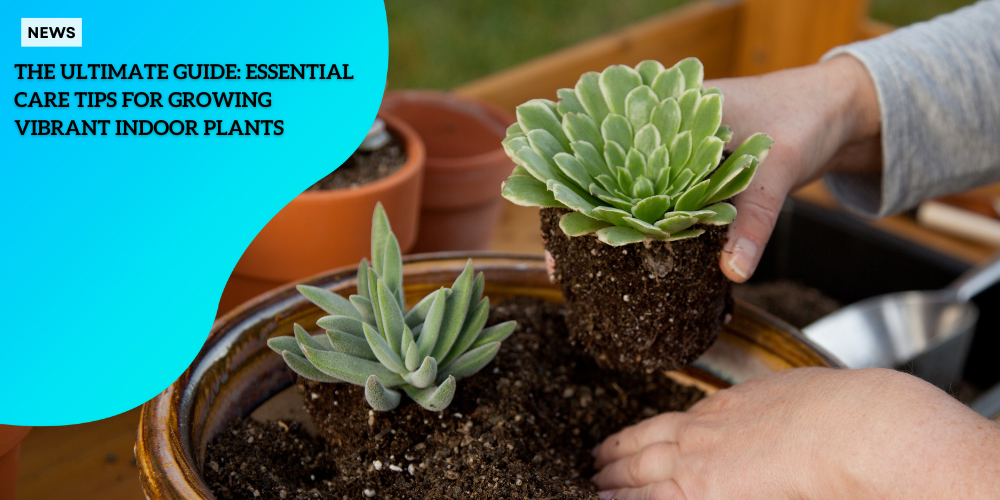The Ultimate Guide: Essential Care Tips for Growing Vibrant Indoor Plants

Anúncios
Understanding the Importance of Proper Indoor Plant Maintenance
Maintaining indoor plants involves more than just occasional watering. It requires understanding the specific needs of each plant and addressing them regularly. Proper maintenance ensures that the plants remain vibrant, which in turn keeps your living space lively and fresh.
Common Challenges Faced with Indoor Plants
Indoor plants often face various challenges that can hamper their health and appearance.
Anúncios
- 🌱Yellowing Leaves: Yellow leaves may indicate several issues, including insufficient light, overwatering, or nutrient deficiencies.
- 🌱Bald Patches: Plants like devil’s ivy can develop bare stems due to lack of sunlight or inadequate pruning.
- 🌱Limited Growth: If plants don’t get enough light or air circulation, they can have stunted growth.
Addressing these challenges promptly is essential for maintaining lush, healthy plants.
The Rewards of Maintaining Vibrant Indoor Plants
While maintaining indoor plants does require effort, the rewards are abundant. Successfully cared-for plants will:
Anúncios
- 🌱Enhance the Aesthetics: Healthy, vibrant plants can significantly boost the visual appeal of any room.
- 🌱Improve Wellbeing: Studies have shown that plants increase oxygen levels, reduce stress, and enhance overall mental health.
- 🌱Create a Focal Point: Strategically placed plants can serve as a stylish focal point in your home decor.
Proper maintenance of indoor plants leads to a satisfying and visually appealing living environment. Remember, a little effort goes a long way in keeping your indoor garden flourishing.
Essential Maintenance for Healthy Foliage
Maintaining healthy foliage is a critical aspect of indoor plant care that provides your plants with the vitality and aesthetic appeal they need.
Here, we’ll delve into the essential maintenance steps required to keep your plant leaves thriving, focusing on the importance of regular leaf dusting, the impact of dust accumulation, and proper cleaning techniques.
The Critical Importance of Regular Leaf Dusting
Regular leaf dusting is not just a superficial chore; it’s fundamental to ensuring your plants absorb the maximum amount of light possible.
Tamara Campbell, a reputable horticulturist, emphasizes that regularly dusting leaves helps your plant absorb light and stay healthy. Think of dust as a curtain over your plants’ leaves.
Each time you clean them, you’re allowing more light to penetrate, which leads to healthier growth and a more vibrant appearance.
How Dust Accumulation Affects Plant Health and Appearance
Dust accumulation poses significant threats to the health and appearance of indoor plants. When dust covers the leaves, it blocks sunlight, which is essential for photosynthesis.
This process is how plants convert light into energy, and any obstruction can hinder their overall growth. Moreover, dusty leaves can appear dull and unkempt, detracting from their natural beauty and the aesthetic appeal they bring to your living space.
Dr. Greg Moore from the University of Melbourne highlights that reduced light penetration isn’t the only issue—dust can also attract pests and encourage fungal growth, which further damages the plants.
Proper Techniques for Cleaning Plant Leaves
Cleaning plant leaves might sound straightforward, but proper techniques ensure you don’t damage them in the process. Here are a few methods to consider:
- Soft Cloth or Sponge: Use a damp, soft cloth or sponge to gently wipe each leaf. This method is particularly effective for larger leaves on plants like the Monstera deliciosa.
- Shower or Hose: For smaller plants or those with numerous tiny leaves, a gentle spray in the shower or a light hose outdoors can wash away dust without causing harm.
- Brush for Delicate Leaves: For plants with delicate or fuzzy leaves, like African violets, a small, soft-bristled brush helps to remove dust without damaging the leaf surface.
- Cotton Swabs: For intricate areas and hard-to-reach spots, use damp cotton swabs to carefully clean.
Regular leaf cleaning should be a part of your routine plant care. Depending on your environment, aim for a bi-weekly to monthly cleaning schedule. Always use lukewarm water when cleaning, as extreme temperatures can shock the plant.
Consistent maintenance of your plant foliage can transform your indoor garden from lackluster to lush. Keep up with these cleaning techniques, and not only will your plants look better, but they will also grow stronger and show fewer signs of common indoor plant issues.
Moving forward, understanding how to place your plants and manage airflow can further enhance your indoor plant care routine. By strategically positioning your plants and ensuring proper air circulation, you can maintain their health and beauty more effectively.
Optimizing Plant Placement and Air Flow
Strategic Positioning Away from Air Conditioning and Heating Ducts
Strategic placement of indoor plants is crucial for their overall health and appearance. One of the most critical positioning tips is to keep your plants away from direct airflow caused by air conditioning and heating ducts.
This is because the dry air from these sources can negatively impact the plant’s foliage, causing it to dry out more quickly than it normally would. According to Dr. Moore, the airflow across the leaf from these ducts can make the leaf look less vibrant and healthy.
Understanding How Airflow Affects Leaf Health
Airflow plays a significant role in the health of indoor plants. Insufficient airflow can lead to humid conditions around the leaves, which may harbor fungal growth and pests.
On the other hand, excessive airflow, particularly from heating or cooling systems, can dry out the leaves, leading to brown, crispy edges. Striking a balance with moderate airflow ensures that plants remain healthy, hydrated, and free from pests.
Identifying Ideal Locations for Different Plant Types
Different plant species have different requirements for light and airflow. For example:
| Light Type | Plants | Care |
|---|---|---|
| 🌑 Low Light | Peace Lily, Snake Plant | Place away from direct light and vents. |
| 🌞 Medium Light | Pothos, Philodendron | Requires moderate light and can tolerate some indirect airflow. |
| ☀️ High Light | Succulents, Cacti | Needs plenty of light but should be placed away from strong airflow to prevent drying out. |
Choosing the right spot for each of your plants involves observing their reactions to light and airflow and making adjustments as necessary. This careful placement helps create an ideal environment that promotes growth and reduces stress on the plants.
Ensuring proper plant placement and airflow not only enhances the longevity of your indoor plants but also helps them maintain their lush, vibrant appearance. With the right balance, your plants will thrive, and your living space will benefit from their natural beauty and health.
Caring for Devil’s Ivy (Epipremnum aureum)
Techniques for Managing and Preventing Bald Patches
Devil’s Ivy, also known as Epipremnum aureum, is a popular indoor plant beloved for its vibrant, trailing foliage. Unfortunately, it can sometimes develop bald patches, particularly when not receiving proper care. To manage and prevent these bare spots, consider the following strategies:
- 🌱Pruning: Regularly prune the vines by cutting back sections that are long and leggy. This stimulates the plant to produce new growth, leading to thicker foliage. When pruning, make sure to use sharp, clean scissors to avoid damaging the plant.
- 🌱Replanting: Take the cuttings from the pruned sections, remove the lower leaves, and replant them back into the same pot or a new one. This practice encourages fuller growth and helps to fill out any sparse areas.
- 🌱Winding and Pinning: For vines that have developed bald sections, gently wind the stems around the pot and pin them down using small U-shaped pins or paperclips. Ensure that the nodes along the stem are in contact with the soil, as this promotes root development and new shoot growth.
Pruning and Replanting Strategies for Fuller Growth
Vigorous and healthy Devil’s Ivy requires periodic pruning and replanting. Here are some effective strategies:
- Prune Leggy Vines: Remove sections of the vines that appear sparse or leggy. Make cuts just above a node, as this is where new growth will emerge.
- Replant Cuttings: Insert the pruned cuttings back into the potting soil. Ensure the cut end is buried, and the nodes are in contact with the soil to encourage rooting.
- Pinning Nodes: Using small pins, secure the bald sections of the vine against the soil. This contact will help the nodes to root more quickly and produce new growth.
Methods for Encouraging Branching and Thicker Foliage
For a lush and dense appearance, Devil’s Ivy requires a bit of encouragement to branch out and fill in:
- 🌱Tip Pruning: By removing the tips of the stems, you encourage the plant to produce lateral branches, resulting in a bushier appearance.
- 🌱Consistent Nourishment: Apply a well-balanced, water-soluble fertilizer throughout the growing season.
- 🌱Consistent Light and Water: Ensure the plant receives bright, indirect light and is watered consistently. Monitor the soil moisture and avoid letting it dry out completely.
By following these techniques and strategies, you can ensure your Devil’s Ivy remains vibrant and lush, offering a stunning display of green foliage.
Implementing these practices will keep bald patches at bay and maintain the dense, healthy growth that makes this plant a favorite among indoor gardeners.
<Please note that there should not be an explicit transition to the next chapter on Monstera Deliciosa Care Guide>
Monstera Deliciosa Care Guide
Benefits of Early Staking for Vertical Growth
One of the best practices for promoting the healthy growth of a Monstera Deliciosa, commonly known as the Swiss Cheese Plant, is to stake it early.
Staking helps this tropical beauty grow upwards, mimicking how it would naturally climb up trees in a rainforest. When you stake a young Monstera, it supports the plant, encourages better leaf spread, and helps to establish its vertical growth early on.
This technique not only gives the plant a structured look but also allows its leaves to access more light, which is crucial for photosynthesis and healthy growth.
Additionally, staking can be beneficial for mature plants as well. If you’ve noticed that your Monstera is starting to sag or spread out too much, introducing a supportive stake can help redirect its growth upward and maintain a sturdy structure.
Preventing the ‘Hunchback’ or Splayed Appearance
Avoiding a hunchback or splayed look in your Monstera is key to keeping it vibrant and lush. Staking is essential in preventing the plant from bending or growing in a disorganized manner.
Without proper support, the stems can become heavy and bend under their own weight, creating that undesirable hunchback appearance.
Using several stakes can allow you to guide different sections of the plant, balancing its weight and ensuring even growth. Tie the stems gently to the stake with soft plant ties, adjusting as the plant continues to grow. This method not only preserves the aesthetic appeal of the Monstera but also ensures it receives equal light distribution, contributing to its overall health.
Mimicking Natural Growing Conditions for Optimal Development
Monstera Deliciosa thrives in environments that closely resemble its natural habitat. To mimic these conditions, consider the following tips:
- 🌱Light: Provide bright, indirect light. Too much direct sunlight can scorch the leaves, while too little can stunt its growth. A well-lit room with filtered light is ideal.
- 🌱Humidity: These tropical plants love high humidity. If possible, use a humidifier or place a tray of water nearby to maintain a humid environment.
- 🌱Temperature: Keep your Monstera in a warm area, ideally between 65-85°F (18-29°C). Avoid cold drafts or sudden temperature changes.
- 🌱Hydration: Water whenever the top inch of soil feels dry to the touch. Make sure the pot has proper drainage to avoid water buildup, which may cause root rot.
- 🌱Fertilizing: During the growing season, feed your Monstera with a balanced, water-soluble fertilizer every month. This will provide essential nutrients for robust growth.
By understanding and replicating these natural growing conditions, you’ll help your Monstera Deliciosa thrive, producing those large, iconic leaves that make it a standout in any indoor plant collection.
As we continue our exploration into indoor plant care, the principles of proper maintenance, strategic placement, and understanding the specific needs of each plant will come in handy.
Pruning and Maintenance Tips
Strategic Removal of Yellow and Brown Foliage
Yellow and brown foliage on indoor plants not only impacts their appearance but can also affect their overall health. Regularly removing damaged leaves is essential to keep your plants looking their best and to maintain their health.
Use sharp, clean shears to cut off any yellow or brown leaves at the base. This prevents the plants from wasting energy on parts that are already deteriorating, allowing them to focus on healthy growth instead.
Improving Plant Appearance Through Selective Pruning
Selective pruning can significantly improve the appearance of your indoor plants. This involves carefully choosing which parts of the plant to prune to shape it and control its size. For example, trimming back leggy or overgrown sections can encourage a fuller and more compact growth habit.
When pruning, aim to cut just above a leaf node to promote the growth of new stems and foliage. This technique is especially beneficial for plants like Devil’s Ivy and Monstera Deliciosa, which tend to become sparse without proper grooming.
Maintaining Proper Airflow Through Pruning Techniques
Pruning is not just about aesthetics; it’s also critical for maintaining proper airflow. Good airflow around and through the plant foliage can help prevent diseases, fungal growth, and pest infestations.
By removing densely packed leaves and thinning out the plant, you can ensure that air circulates freely. This is especially important if your plants are located in spaces where air movement is limited. Focus on areas where leaves overlap or crowd each other, as these spots are more prone to mildew and pest problems.
Effective pruning not only enhances the visual appeal of your plants but also supports their long-term health and vitality. As you move forward in your indoor plant care journey, regular maintenance like pruning will ensure your plants remain lush and vibrant.






